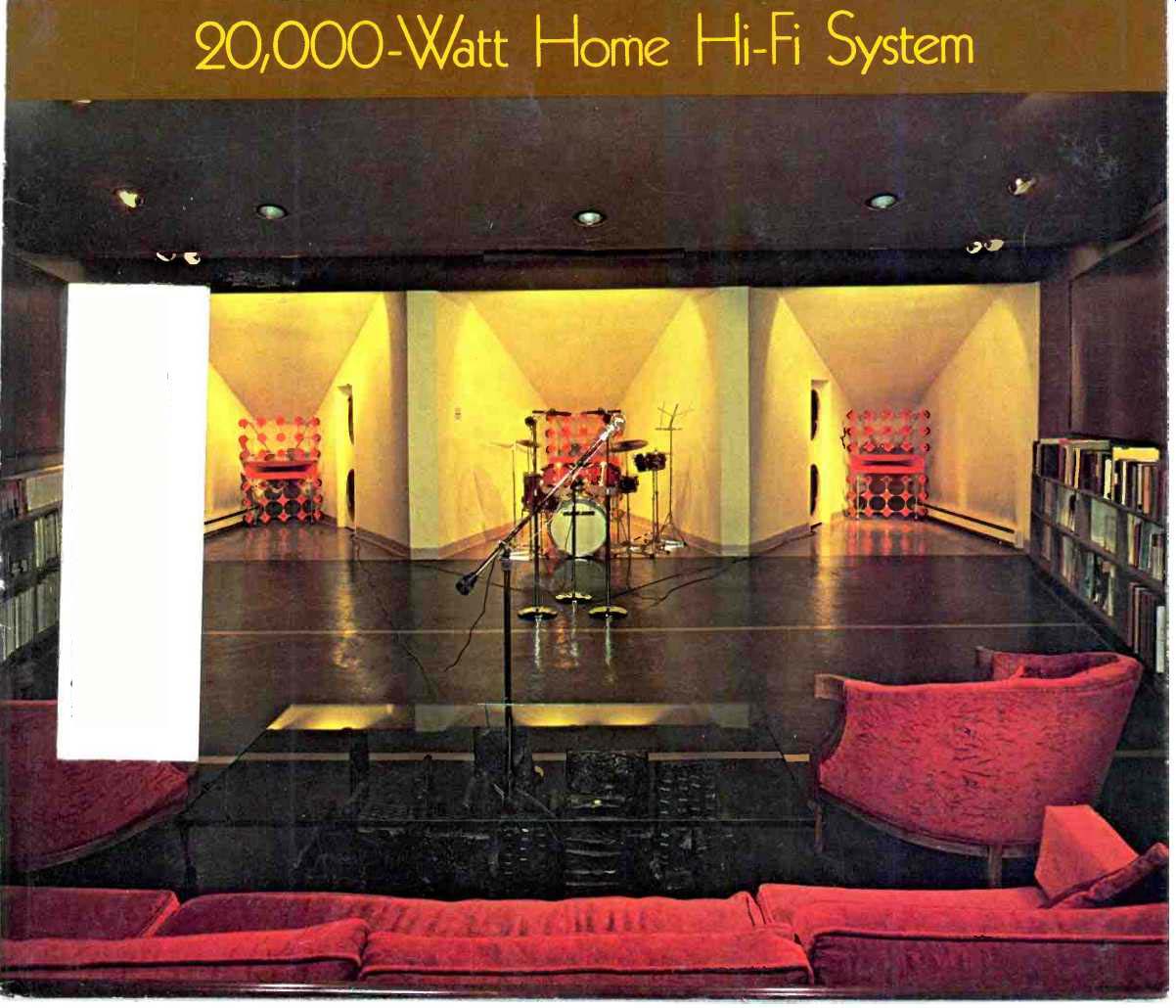
by Richard S. Burwen [Burwen Laboratories 12 Holmes Road Lexington, Mass.
02173, USA]
Every audiophile has sometimes fantasized about the components he'd get if he had unlimited funds, the most knowledgeable design engineers to serve him, and a couple of highly qualified technicians for construction and installation. But that's where it ends for most of us-as an occasional fantasy.
Not, however, for space/electronics engineer Richard S. Burwen of Burwen Laboratories, Lexington, Mass. Although his primary professional activity until recent years has been circuit design in many fields outside of audio, Dick Burwen can (and has) indulged himself, audiowise, as probably no one else in the world has been able to. His incredibly elaborate home listening and recording system not only includes many of the best commercially-available components, but numerous facilities which can't be purchased anywhere, at any price. These are available only if you happen to be one of the most inventive audio engineers of the day, Richard S. Burwen. Recently we took a guided tour of his home system. His description of it follows.
-Editor.
----------
THIS EQUIPMENT has taken about 12 man-years to design and build, starting as far back as 1962. My objective is to produce the maximum entertainment value from prerecorded program sources and from live recordings. The room and equipment are designed for reproduction over five speaker systems at the original live sound levels and with more than 100 dB dynamic range.
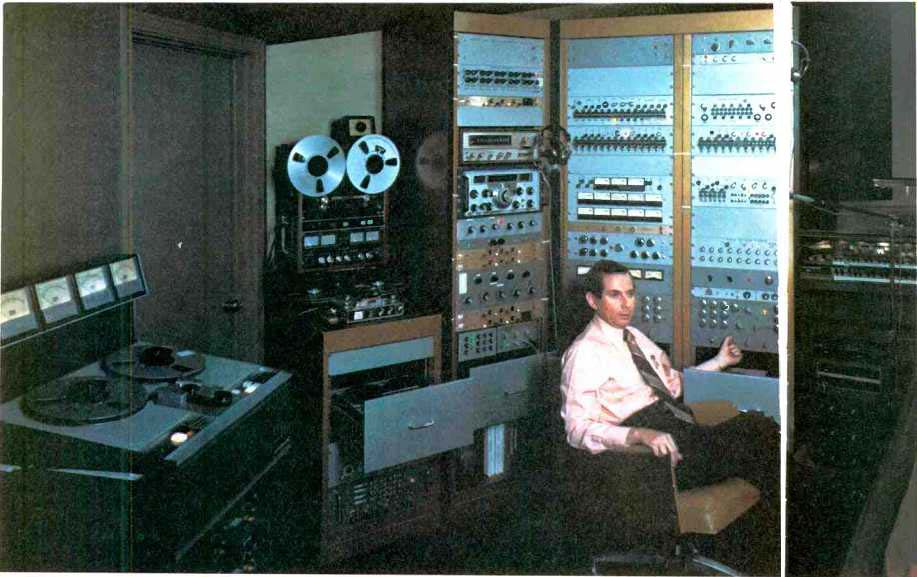
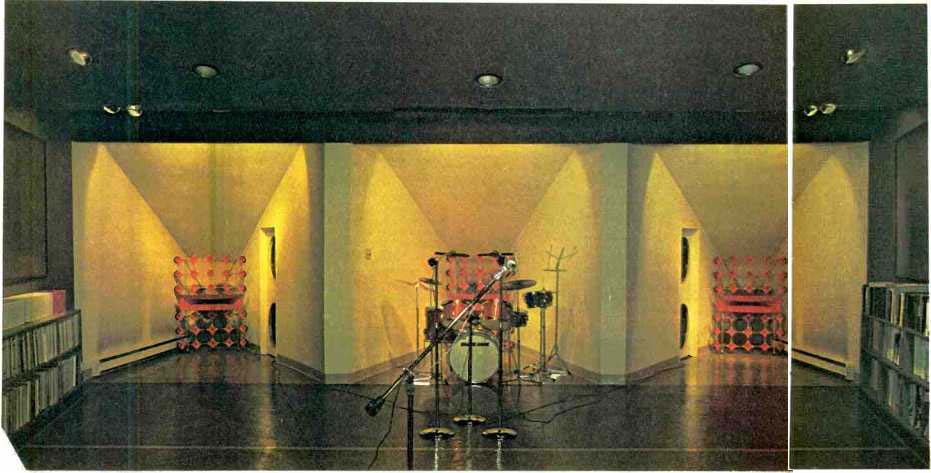
top: Richard S. Burwen relaxes at the controls of his incredibly
elaborate home listening and recording system.
above: Taken from just behind the main listening area, this photo shows the three horns which make up the front channels.
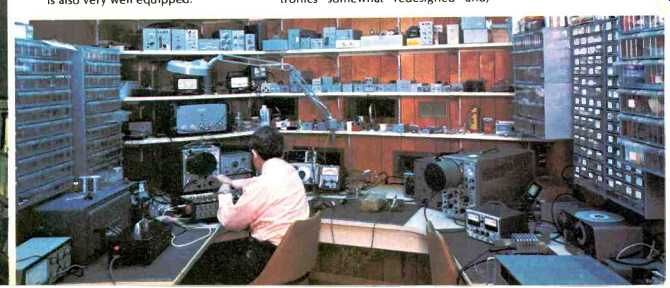
above: Burwen's laboratory is also very well equipped.
Playback System
Mounted in the racks are signal processors for recording and playback which are normally separate but can be interconnected; you can get an idea of the functions of the playback portion of the system from the block diagram. We start with the Program Selector switch panel which selects various program sources. Among the six tape machines I have a four-channel 1/2-in. 3M machine, a four-channel 1/4-in. Sony TC-854-4, two quarter track stereo decks, a cassette changer, and a half-track 1.25 in. stereo machine. All of these decks have had their electronics somewhat redesigned and, although their performance is quite good, they still need more rebuilding. For broadcast reception I have a Fisher 10007 FM tuner here in the listening room and a 5001 receiver in the master bedroom which sends signals to the selector switch. These receivers have been used together in past years when the Boston Symphony broadcasts were available in four channels via two stations combined. There is also a National HRO 500 for AM and shortwave reception connected to a 400-ft. long wire antenna via a special preamplifier and there is a Motorola TV receiver. All the receivers have been modified to provide higher quality audio. In addition, the FM tuners each feed through complex active notch and low-pass filters to completely remove the 19-kHz stereo subcarrier and ultrasonic frequency components without attenuating the higher audio frequencies.
The two Dual 1019 turntables have phono cartridge preamplifiers built into their bases. These preamplifiers are individually equalized to provide flat response on an NAB test record when using JVC CD-4 phono cartridges. The two phono preamplifiers then feed into a two-channel phono mixer which provides input and output buffering for a CD-4 demodulator.
The Program Selector switches provide five stereo outputs from the previously mentioned sources as well as the Recording Mixer and 15 spare input jacks distributed around the studio. In addition, the Program Selector switches can connect four Burwen Labs Model 2000 Audio Processors'.2to the various tape machines and the phono mixer for decoding tapes recorded through the Audio Processors and also experimental encoded records. [3]
Following the Program Selector switches is a pair of three channel Stereo Control Systems. These units, which provide signal mixing and equalization for Lows, Bass, Middles, Trebles and Highs, were described in the October 1974 issue of Audio. When construction of the system began, three channels were planned and several of the playback processors are three-channel units. For four or five channels one Stereo Control System is normally used for the front and the other for the rear.
Connected into the front Stereo Control System is a series of signal processors, each of which can be bypassed. The first is a 250 Hz to 4 kHz Dynamic Noise Filter for processing telephone and shortwave signals. This unit can be switched to the incoming telephone lines via an active transformer and was the developmental predecessor of the Burwen Laboratories Model 1500D Dynamic Noise Filter. Next, the signal passes through my original three-channel Dynamic Noise Filter. This unit incorporates notch filters to get rid of various hum components and provides 6-, 12-, or 18dB/octave cutoffs which can be either fixed or varied by the signal. Currently, this unit is undergoing modification to incorporate some of the latest advances in the art of dynamic filtering.
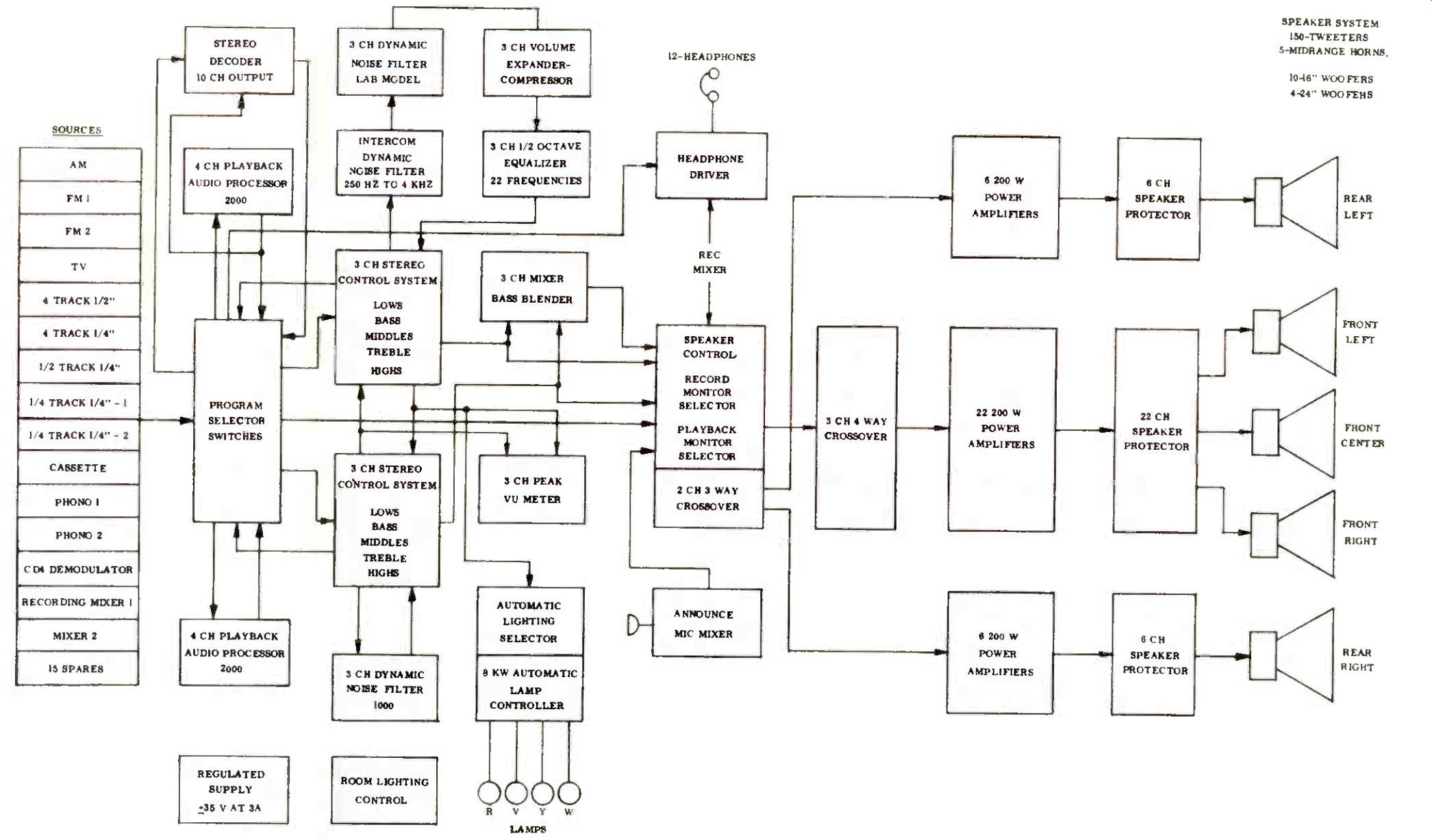
Fig. 1--Block diagram of playback system.
Following the lab model DNF, the signal goes through a three-channel volume expander-compressor. This unit expands or compresses on a variable dB/dB basis over a 30-dB input range and has a continuously variable decay time adjustment. In contrast with the usual volume expanders which have flat response controllers, this unit incorporates bass boost in its controller to emphasize the beat in popular music and heavy crescendos in classical music. After the expander-compressor, the signal is processed by a three-channel half-octave equalizer having 22 control frequencies.
Each frequency can be boosted or attenuated in 2-dB steps and the three channels are accurately ganged to within 0.2 dB. In combination with the tone controls on the Stereo Control unit and the 6-, 12-, and 18-dB/octave cutoffs in the three-channel Dynamic Noise Filter, just about any useful frequency response curve can be attained with all three channels matched.
Connected into the rear Stereo Control System is a Burwen Laboratories Model 1000 Dynamic Noise Filter 6 having modules for three independent channels. In addition, one of the new Burwen Labs Model EQ3200 Frequency Extender-Equalizers is ready to install for processing the rear channel signals. The signal levels of the Stereo Control System are monitored by a three-channel peak VU meter. This instrument will take a reading in as short a time as 20 µS and will hold the reading for an hour so you don't have to stand around watching it. You can simply come back later and see what the highest peak in the program was.
On the table to the right of the rack is a set of Burwen Dynamic Noise Filters which are used for demonstration purposes. There is a professional Model 1500D for telephone lines, a Model 1500A for network use, and a Model 1100 independent channel unit for general purpose high fidelity applications. On top is our early Model 1200 consumer unit and the current Model 1201. These are all connected in series and can be switched into the front Stereo Control System.
Another device whose output can be selected by the Program Selector switches is a Stereo Decoder. The Decoder has 145 potentiometers on the front panel including 20 10 turn digital pots. I can set up any matrix I want, such as QS or SQ, on the digital pots, test it out, and then set it up permanently on the screwdriver adjustment pots. The system allows me to switch in any of six combinations and is used not only for quadraphonic records but for producing various surround effects from one- and two-channel records.
The system has phase shifters in it which provide left and right signals at 270° and 180°. These may be added in any combination to produce a five-channel output.
The main outputs of the three-channel Stereo Control System feed both the three-channel Mixer and Bass Blender and the Speaker Control System. The Mixer will accept three three-channel stereo signals, mix them together, and blend the bass below 60 Hz so that all the woofers are working in unison. This enables the system to produce more bass power with less distortion. In addition, it cancels vertical turntable rumble.

Fig. 2--Front view of speaker control.
The Speaker Control unit permits monitoring of the playback signal from various parts of the sound system in one, two, three, four, or five channels. For example, you can select the outputs of the Stereo Decoder, the Stereo Control System, the three-channel Mixer-Bass Blender, and the outputs of the Model 2000 Audio Processors. The record section of the Speaker Control System allows monitoring of the various parts of the record mixer, which we will get into later. The construction of this unit is typical of the more recently built equipment. The gain controls consist of high quality, five-gang step switches, having 1-dB steps over a 30 dB range. All the resistors that determine the gain are 1% so that the channels are very accurately matched. The unit incorporates about 50 Burwen Laboratories UM201 Universal Mixing Amplifier modules to perform amplification and mixing functions. The continuously variable faders, which are ganged for five channels and for two channels, consist of precision conductive plastic types. On the rear there are 65 BNC jacks for the audio signals plus four- and five-pin audio connectors for power and crossover outputs. Units in the rack are generally interconnected by means of RG62U coaxial cable with BNC plugs and the racks are quite full of cables for this use.
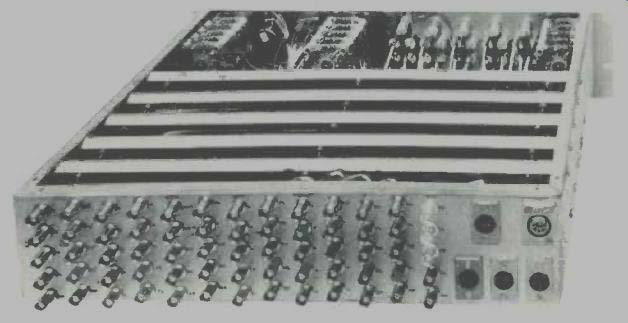
Fig. 3--Rear view of speaker control.
The performance specifications of the Speaker Control system are typical of most of the specially built equipment.
Each chassis must have less than 0.1% total harmonic distortion at unity gain and 7-V output at any frequency from 15 Hz to 20 kHz and be flat within 0.1 dB. The dynamic range ahead of the record or playback level controls is over 115 dB. Since this particular unit feeds the active speaker crossover networks, extremely low noise is required when the speaker level controls are turned down. Under this condition the noise output is only 2 EN or 130 dB below maximum output. It might seem that this noise is lower than needed but bear in mind that at maximum output the system can clip 10 dB beyond producing 20,000 watts equivalent level.
Speakers and Crossovers
Each of the five speaker horns is 13 ft. deep and has about 64 sq. ft. of mouth area. The horns are conical, in preference to exponential, in order to produce a gradual low frequency rolloff, instead of a sharp cutoff. As it turned out, due to reinforcement from the room, the average low frequency response on one-third octave noise bands is flat down to 16 Hz without equalization. Each speaker horn contains 30 Cerwin-Vega tweeters, a midrange horn with two JBL 2440 drivers, and two Empire 16-in. woofers. In addition, the left front and right-front horns have two 24-in. Cerwin-Vega woofers mounted on the doors. These woofers are equipped with feedback windings to linearize their acoustic output over their range.
The rear speakers, which are shown diagrammatically in the room plan, point towards the rear of the room so as to provide reflected sound. At the principal seating position on the sofa, the time delay from the rear speakers, including the reflection, is about the same as the time delay from the front speakers. Thus, an electronic time delay system is not required.
As you can see from the room plan, the storerooms between the front speakers constitute a 200-cu.-ft. back enclosure. The rear speakers vent into the room at the ceiling level in the manner of a bass reflex speaker. In the case of the right-rear speaker, the venting permits the use of a 30 in. exhaust fan located in the garage above. The entire room is solidly constructed of concrete, cinder block, and extra heavy plaster. Although the horn walls are made of 4-in., filled cinder block, I am amazed at how much these can vibrate. If I were to build a room like this again, I would use 8-in. thick walls. The ceiling is wavy so as to diffuse the sound, and the low points of the ceiling conceal heavy steel beams which support the house above. Optimum sound absorption occurs due to the upholstered furniture, books, records, and two 4 ft. by 20 ft. panels on each side wall.
These panels consist of a sandwich of plastic on acoustic tile on cinder block. They absorb middle frequencies while reflecting high and low frequencies.
To drive the speakers there are a total of 17 Phase Linear 400 amplifiers, 11 of which are located in the storerooms at the front and three are located in each of the rear horns.
Each woofer, midrange horn, and set of 9 or 12 tweeters is driven from one 200-watt amplifier channel. With the electronic crossover at 50, 400, and 5,000 Hz ahead of the amplifiers, the speakers can produce the same sound level that would be produced by a single 20,000 watt amplifier. The
crossover network for the front speakers is located in the storerooms between speakers, and the crossover for the rear speakers is part of the Speaker Control panel. The crossover filters utilize UM201 modules to produce 6-, 12-, 18-, and 30-dB/octave cutoffs for the various drivers. In addition, the crossover provides equalization to flat acoustic response. In designing and adjusting the crossover networks, I used one-third octave noise measurements based on a six microphone average of omni-directional microphones for low frequencies and an average of two cardioids located in front of the left-front and right-front horns for the high frequencies. The microphones used for adjusting the crossover frequency response are the same ones used for making recordings here; so the entire system is flat. On one-third octave noise bands, it measured flat within 11 dB from 15 Hz to 20 kHz. Nevertheless, I find that when reproducing much of the prerecorded program material available I use from 3 to 30 dB of low frequency boost.
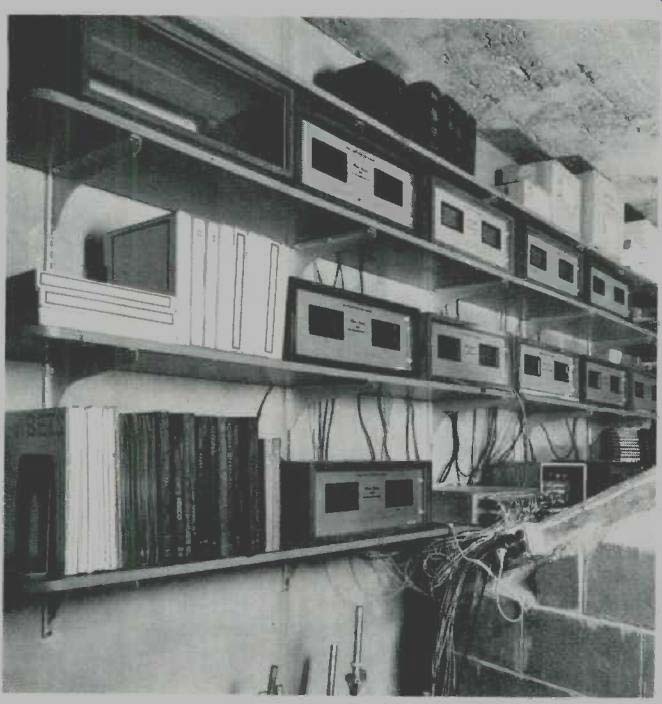
Fig. 4--Room in back of front speakers holds the Phase Linear 400 amplifiers.
When you have a high-powered sound system like this, one of the difficult problems to solve is to keep from blowing out 169 speakers at once. That is the reason for having so many speakers in the first place. The tweeters are wired three in series so that each can receive only 1/3 of the amplifier output voltage. All the speakers can handle the clipping levels of their respective amplifiers without mechanical damage. Nevertheless, during sustained clipping the voice coils can get too hot. To prevent overheating, there is an elaborate speaker protection system in each of the rear horns and one for the three front horns. The protection system has a total of 34 channels, each of which measures the amplifier power output, computes the voice coil temperature, and disconnects its speaker with a relay before the voice coil gets too hot. The same system eliminates turn-on and turn-off thumps. In over a year of operation there has been no damage to any of the speakers.
You may wonder why it takes so much power to feed such efficient speakers. I have found that when reproducing a live drum set out of any one of my five horns at the original sound level, the peaks can reach within 3 to 6 dB of the clipping level when the drummer is playing as loud as he can.
For prerecorded music, however, much less power is needed because the high peaks are clipped off during the recording process.
Automatic Color Lighting System
The electronics for the color lighting for the front horns consists of a four-channel silicon-controlled rectifier a.c. phase controller capable of delivering 20 A at 115 V on each channel. Three channels are automatic, and the lamps are now switched so that the bass is red, middles are purple, and the highs are yellow. The control system receives its signals from the front speaker Stereo Control unit. Lamps can be switched to change the colors versus frequency and to change colors with location of the sound. It works much more slowly than conventional color organs so the lights do not flicker and cause annoyance after a few minutes of watching. The attack time is about 50 mS but it takes about 20 S for the light to decay, light intensity is proportional to loudness.
Recording System
When making live recordings I generally record simultaneously on two four-track machines and one two-track machine. All my tapes are recorded in encoded form using the Burwen Labs Model 2000 Audio Processor and then played back through the same type of processor. The machines and processor together are capable of a 110-dB dynamic range.
Combined with the microphones and mixer, all of which add noise, the final reproduced dynamic range, even on a second generation tape, is over 100 dB. Basically what the recording mixer does for most of the inputs is to provide a master gain control followed by five separate gain controls which can send that input channel to any of my five speaker systems in any desired amount. There is an encoder which permits me to matrix five channels into four, with leakage between channels down 12 dB. On playback the four-channel signal can be matrixed back to five channels down 12 dB. On playback the four-channel signal can be matrixed back to five channels using a portion of the Stereo Decoder mentioned earlier.
Eight of the inputs to the recording mixer come from the Program Selector switches which can, therefore, provide any of the sources available to the playback system. Other inputs come from the Stereo Control Systems and the Mixer and Bass Blender after these sources have been fully processed. A set of five inputs is allocated to my Lowrey electronic theatre organ, a rhythm unit, and a synthesizer which will be added later.
The organ plays through a device I call the Spatial Modulator which is an electronic replacement for the rotating Lesley speaker system built into the organ. This allows the organ to play through my main speakers instead of its own and recordings made by direct connection sound exactly like the real organ. The Spatial Modulator has been working for three years but still consists of an open breadboard circuit sitting on the table next to the organ console at the mouth of the left rear horn. This circuit produces modulation side band frequencies which are distributed among the five horns along with the main organ signal in such a way as to provide frequency and amplitude modulation. On pure tones the effect very closely simulates the Lesley; on more complex signals the Spatial Modulator sounds quite different from the Lesley providing a much purer bell-like sound which I happen to prefer.
There are 27 microphones in my recording system. Seven use Altec 28A capsules and their vacuum tubes have been replaced by low-noise FET amplifiers of my own design. Of these, three are permanently mounted on the 10-ft. Steinway piano located in the right rear horn. These three microphones have their own amplifiers and tone controls mounted right in the piano. Incidentally, this piano which I think is a beautiful sounding instrument, is about 100 years old.
Twenty of the microphones have specially designed amplifiers built into them which are capable of delivering a high output signal level of +20 dBm. These microphones, which utilize Schoeps capsules, have a noise level of 15-dB SPL and are capable of handling 140-dB input. Each microphone is equipped with a gain switch for close, medium, or distant miking and is built into concentric pipes for double shielding. They operate on ±15 V d.c. and have 5-pin connectors with double shielded cable.
Associated with 28 of the mixer inputs, and almost ready to install, is a set of equalizers' which provide two gain switches and six tone switches per channel. The tone switches provide peaking at 16 Hz and 24 kHz and are able to tilt the response in other portions of the audio range. The total range of equalization is more than ±25 dB and the dynamic range when flat is 120 dB.
Two of the mixer panels, each 19 in. wide x 5 1/4 in. high, handle 14 inputs and deliver two five-channel outputs each.
Inputs can be switched to the five-channel output buses in groups. Generally one five-channel output bus is utilized for monitoring while the other is used for recording. Another mixer panel handles 24 inputs and a fourth panel mixes together six three-channel stereo signals. One set of three channels comes from a three-channel microphone mixer designed to power three of the special FET amplifiers associated with the Altec 28A microphones. Sixty-two of the input channels have monitor switches which connect into mono and stereo monitor preamplifiers and 19 channels are equipped with phase inverting switches. The outputs of the four input mixing panels are combined at a master mixing panel which can send signals to a reverberation unit and receive them back. The master unit permits recording from either of the two five-channel mixed signals, contains the 5-to-4 matrix encoder, and provides a simultaneous mix to two channels. The various input and five-channel mixed signals, as well as two, four, and five-channel playback signals, can be monitored on a set of 13 peak VU meters. These meters utilize Burwen Laboratories Model VU306 Peak VU Detector modules which convert an ordinary VU meter to peak reading. The meters will register peaks as short as 10 µS and hold the output steady on the meter for 2 S. Each meter has two ranges, one with 0 on the meter at 0 dBm, the normal system calibration level, and a high scale with 0 at +10 dBm (2.5 V) which is the normal peak program level for the system. Extra headroom in the system allows peaks to reach +20 dBm before clipping. The construction of the mixing panel is similar to that of the Speaker Control unit. Although extremely compact, each chassis performs functions comparable with those of a 5-ft.-long studio control console.
Since the recording controls are located in the same room with the music, monitoring must be via headphones and the peak VU meters. A separate binaural headphone driver unit associated with the playback system permits monitoring of various sections of both the record and the playback system.
This unit is capable of driving up to 20 sets of AKG 50 headphones and contains equalization to flatten the response of these particular phones. The headphone driver also allows variable blending of the sides to reduce the exaggerated stereo effect.
Both the recording and the playback system are powered from a pair of hefty ±25 V and ±35 V highly regulated power supplies. These supplies deliver 5 and 2.5 A respectively and have hum-bucking transformers with triple mu-metal shielding. Each panel in the rack contains its own ±15 V or ±18 V shunt regulator system which operates from these common supplies. The use of shunt regulators prevents a.c. power supply ground currents which could cause crosstalk between units.
Besides the equipment in the racks, I own a portable recording mixer. This unit has 10 inputs and two outputs and was built by Mark Levinson Audio Systems to my specifications. Along with this mixer there is a 10-channel version of the wide dynamic range equalizer system and a Model 2000 Audio Processor.
All the developmental work for the past 10 years has been performed in my laboratory occupying two adjacent rooms. The abundance of equipment, parts, and test leads makes an environment conducive to high efficiency.
Recordings
Because of the liveness of the studio, which has a reverberation time of about 0.75 S, I thought at first it was nearly impossible to achieve a decent recording. My technique has developed in the past two years, however, so that now I consider the liveness a great benefit. The East Bay City Jazz Band recording on Burwen Labs Perfectly Clear label was made with 14 microphones placed at about 10 in. from each instrument with two microphones used for ambience pickup. Because of the extreme leakage between microphone channels due to the room, all the mikes had to be operated at nearly the same gain and placed in such a manner that the leakage contributed to a desirable stereo effect. Lately I have been recording with only four cardioid microphones, three for the front speakers and one for the rear speakers.
The front microphone heads are generally 16 in. apart and 6 ft. from the performers. If the performers are placed along an arc around the microphones during the recording, they appear to be lined up linearly across the front of the room on playback. The rear channel microphone is typically about 6 ft. behind the front microphones, is aimed at the performers, and feeds the rear speakers at a level of about-25 dB. This arrangement seems to produce a good two-channel mix and was used in making the Babson College Dixieland Band record. Most of my in-studio tapes have been jazz and dance music by such artists as Norm Bistany, Dick Well stood, and Bobby Hackett plus some operatic arias by Richard T. Gill. Next I would like to get into chamber music. Well, that is my system.
References
For more detailed information on equipment in the author's sound system refer to the following articles by R. S. Burwen:
1. "110 dB Dynamic Range For Tape," Audio, p. 49, June, 1971.
2. "Design of a Noise Eliminator System," Journal of the Audio Engineering Society, Vol. 19, No. 11, p. 906, December, 1971.
3. "100 dB Dynamic Range Disc Recording," Audio Engineering Society preprint no. 995 P-4, September, 1974.
4. "A Stereo Control System," Audio, p. 20, October, 1974.
5. "A Dynamic Noise Filter," Journal of the Audio Engineering Society, Vol. 19, No. 2, p. 115, February, 1971.
6. "A Dynamic Noise Filter for Mastering," Audio, p. 29, June, 1972.
7. "A Wide Dynamic Range Program Equalizer," Journal of the Audio Engineering Society, Vol. 23, No. 9, p. 722, November, 1975.
(Audio magazine, Apr. 1976)
Also see:
How Valid is the FTC Preconditioning Rule? (Sept. 1975)
Power Amplifiers and the Loudspeaker Load: Some Problems and a Few Suggestions (Aug. 1977)
= = = =